Geoffrey Farmer
How Do I Fit This Ghost Inside My Mouth
Vancouver Art Gallery
May 30 - September 7, 2015
Spanning the past 15 years of Geoffrey Farmer's career, How Do I Fit this Ghost Inside My Mouth is an exhibition brimming with multiple pasts, presents and futures. The installations throughout the second floor of the Vancouver Art Gallery are brought to life by Farmer's intricate understanding of colour, atmosphere and sound. Farmer melts time and converges histories.
Early on in Farmer's tour of the exhibition with VIA, the artist paused to reflect aloud on what is a beginning, and what is an ending... and if there can ever even be an actual beginning or ending. These ponderous observations on time stream like a comet tail throughout each series of work in the exhibition.
Large monolithic black doors mark the entrance of the show. Entitled Sister Doors they serve as a nod to a beginning that Farmer's sister is responsible for: his introduction to art making. When the artist was 21, she invited him to an art class that spawned a critical bolt of illumination. Farmer discovered his life's calling and passion. The doors, in their replicative splendour, also pay aesthetic homage to a sculpture made by artist Louise Nevelson in 1962, this is also marks the year Farmer's sister was born.
Crossing over the threshold into the central rotunda visitors enter into an even earlier beginning. Up for study, the creation of the building that currently houses the Vancouver Art Gallery. Farmer researched the history of this exhibition space first, its origins as the provincial courthouse building. It was in 1983, that the Vancouver Art Gallery repurposed the building to house its collection, offices and exhibitions. Farmer's research led him to the architect responsible for the building, Sir Francis Mawson Rattenbury. Intrigued by the life that Rattenbury lead, Farmer dove into his somewhat dramatic and scandalous personal history, the results of which are theatrically displayed in front of the viewer. A painted vintage movie backdrop from Los Angeles lays the theatre-like scene for four sculptural figures representing the key players in Rattenbury's demise and eventual murder. Provocations of the past, the further past and the present all collide into yet another beginning.
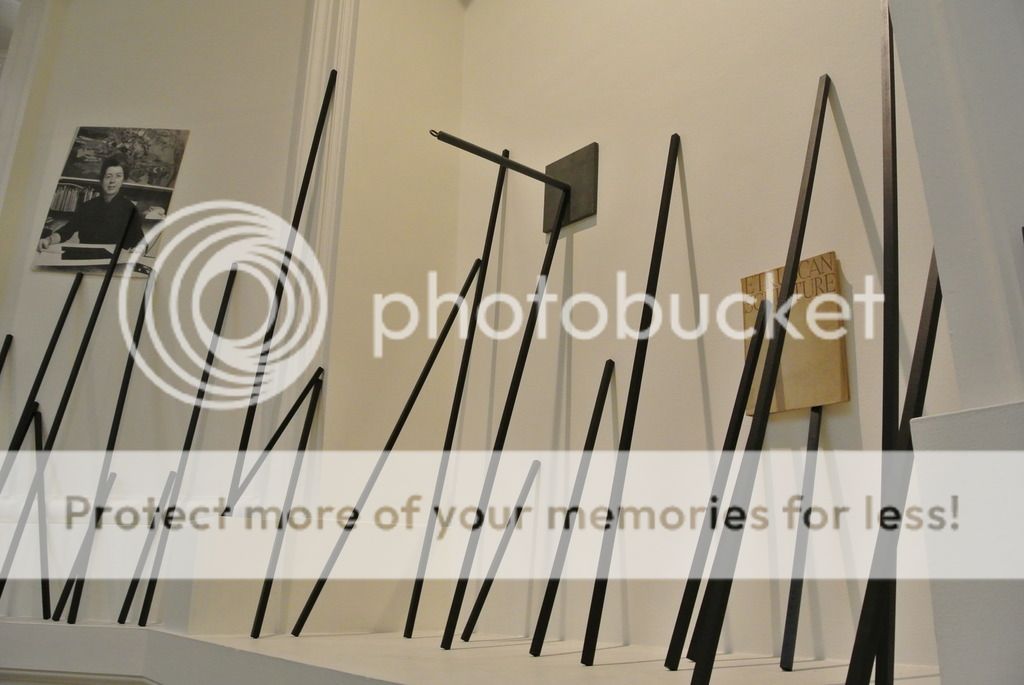 Installation View of
Installation View of
Farmer's research into the depths of the building also led him to gathering a plethora of objects from the Vancouver Art Gallery's catacombs (a museological term of endearment by staff at the gallery for the art storage facilities below, these were once jail cells for the courts). His work that follows up the stairs and onto the second floor from the rotunda is a scattered web of objects; some that were collected or created by Farmer, others that were dragged up from the catacombs, or pulled from offices elsewhere in the building. Muddy waters, visitors wade through an intense accumulation of static and moving objects, not knowing what direction to take. Where does Farmer's work end and where do the relics of bygone years begin, we aren't meant to know, but to experience and absorb.
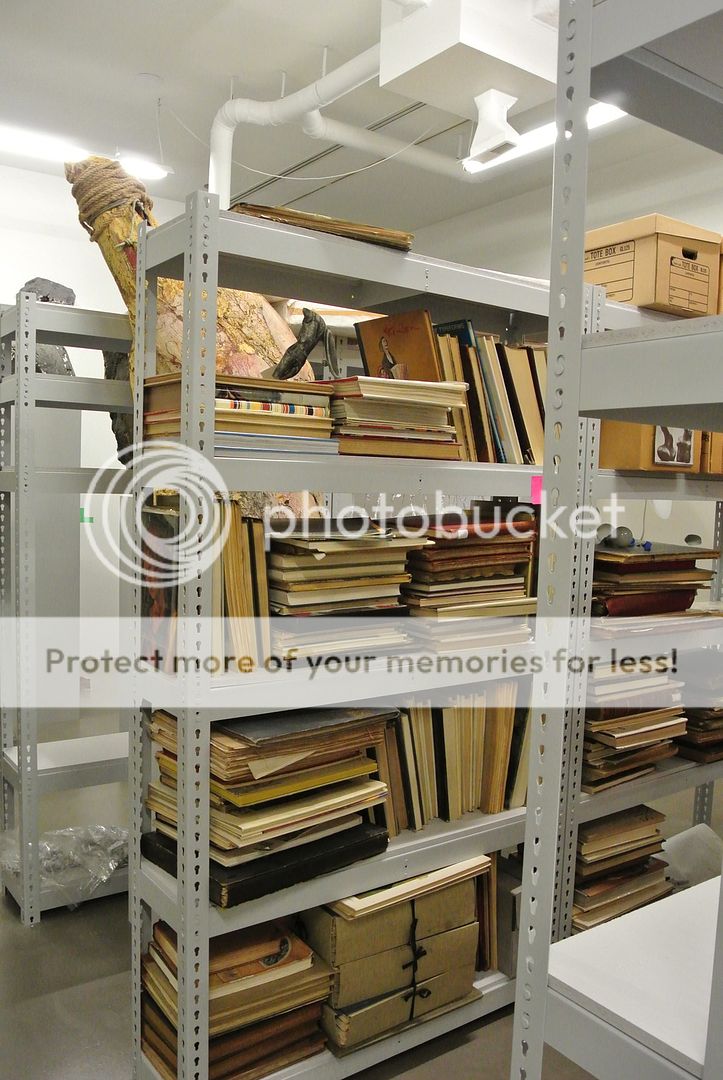 Installation View of
Installation View of
Following the disruption and chaos of 'object intermingling', the next installation travels even further back in time, two million years to be precise. Farmer's The Last Two Million Years, (2007) represents a complete re-rendering of a book by the same title. Every object printed on all of the pages of this book has been cut out and removed from its chronological history, then re-dispersed into a categorization of Farmer's choosing. Ancient Junk boats, canoes, viking ships and sailboats are collected and displayed together whilst all figures riding on horses join forces on another plinth, and so on and so forth. The results? A fascinating visualization of two million years in a single space. Time morphs into a continuous present, the objects are free from existing as a part of a chronologically ordered series. Watching visitors' brownian movement through the space makes time itself appear elastic. The gravitational pull of random visual clusters offer a multiplicity of opportunities for navigation and new stories to emerge.
 Installation view of
Installation view of
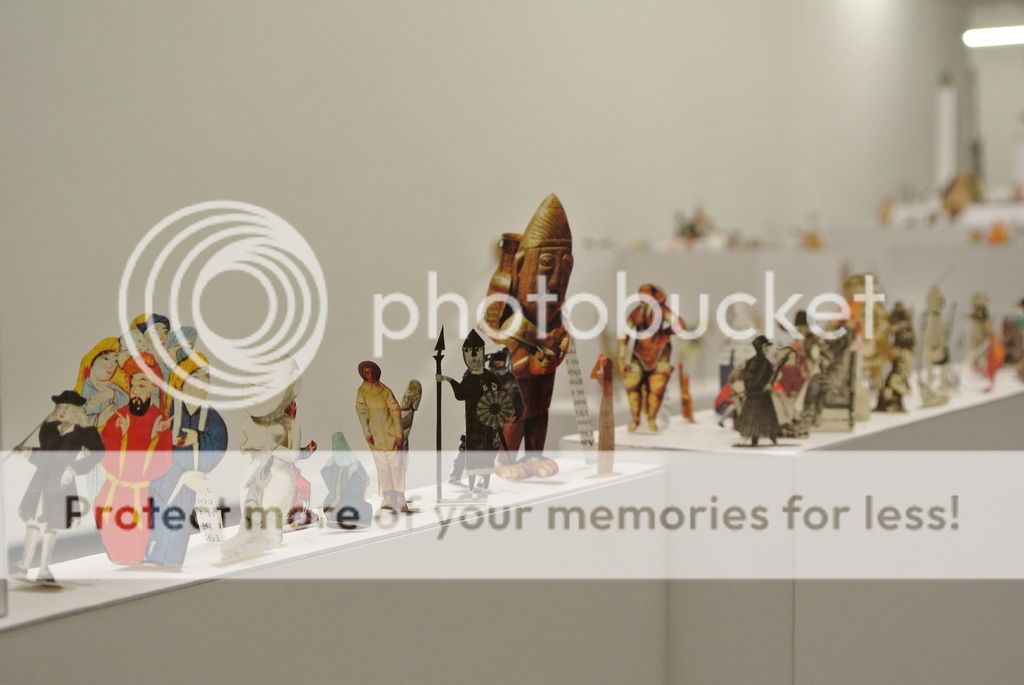 Installation view of
Installation view of
How Do I Fit This Ghost in My Mouth has been five years in the making. Vancouver Art Gallery's curator Daina Agaitus stated that the show was on the programming roster at the gallery since 2011. It came about shortly after the gallery's significant acquisition of The Surgeon and the Photographer, a magnificent installation of 365 puppets crafted using cloth bodies and printed imagery sourced from books that had been collected from Mcleod's bookstore here in Vancouver. This is the first time that the gallery has shown this monumental work.
The destruction and reconfiguration of these materials, again demonstrates Farmer's fixation on detail. Each puppet is a surreal metaphysical manifestation. The intensity of the sharp-cut paper outlines and the odd juxtaposition of imagery is balanced through Farmers use of soft fabric draped bodies. The familiar, removed from its context, becomes dystopian and dreamlike. Unlike the bright crisp white space of The Last Two Million Years, visitors are invited into a dimly lit ambient space that provokes a theta wave state. The dim spotlights throughout the space create the sensation of dawn or dusk - the magic hour, a perfect time for these puppets to come to life.
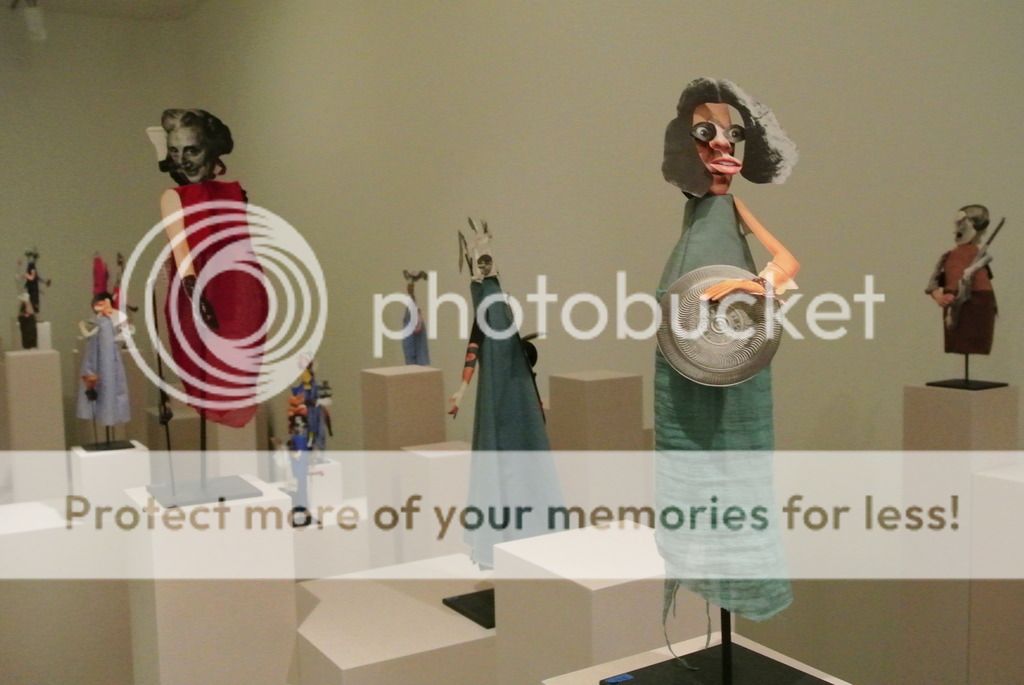 Installation view of
Installation view of
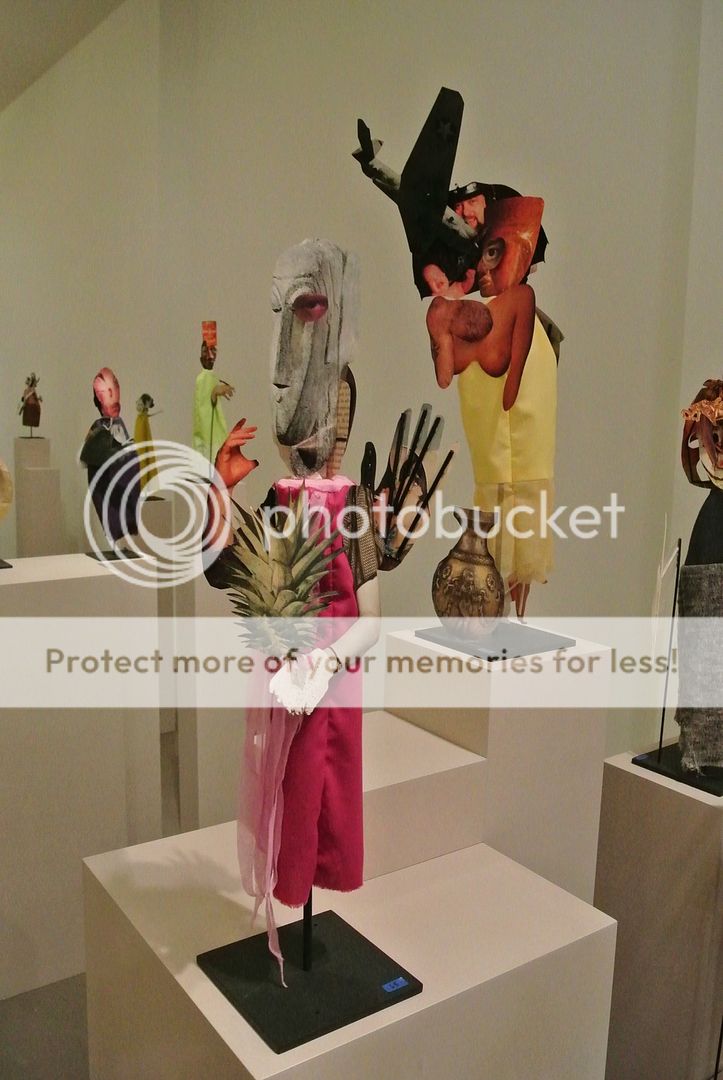 Installation view of
Installation view of
One of Farmer's most recent works on display, Let's Make the Water Turn Black, uses Frank Zappa's life story as a structuring device. A kinetic installation that combines sound, lighting and sculpture to present visitors with a phantasmagoric hallucination. Once the installation has begun in the morning at the gallery, every seven minutes of time that it runs represents one year in the life of Zappa. This work was created in collaboration with Brady Marks who assisted with the kinetics, sound and programming. The namesake of the piece is also the title of an odd Zappa tune (as if there were any other kind). All sculptural elements sit atop a large white platform that spans the entire room, this base reflects the intense shifts in the coloured lighting that is projecting down onto the installation. Plants, a lion that splits in half then closes to whole again, an antique plate camera, broomsticks that spawn palm fronds, a paint bucket full of lightbulbs, a spinning wheel; these are but a small selection of the profusion of objects that invoke the spirit of Zappa.
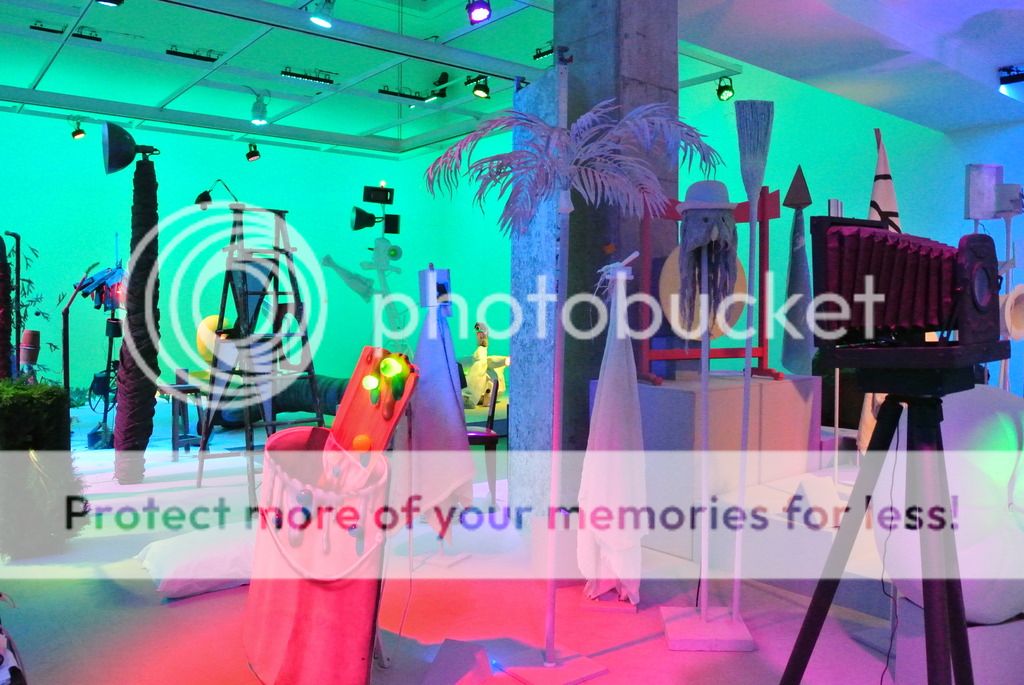 Installation view of
Installation view of
The sound used in the installation captures elements of Zappa's actual life as well as recorded events that would have occurred during his lifetime. The intensity of the installation could be summarized with a song lyric pulled directly from Zappa's tune:
Colour flashing, thunder crashing, dynamite machine. Wait till the fire turns green...
Intense and hypnotic, Let's Make the Water Turn Black is a challenging work, reactions to it will undoubtably be infinite. With every visitor comes a new and altered state.
 Installation view of
Installation view of
With a practice that is grounded in reconfiguring, recalculating, resampling and most importantly, exploring the 'objectness' of objects, Farmer has integrated a complex nexus of histories into his show. There are many other inquisitive adventures that await gallery visitors to How Do I Fit This Ghost Inside My Mouth. We encourage you to go when you have at least a couple of hours, it is needed to fully take in the show.
At the start of the tour, Farmer suggested, as have others before him, and others before them: beginnings.... are, put simply, just proclamations. Farmer's proclamation for gallery visitors?
Begin, begin again.


